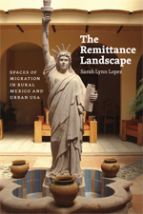The Remittance Landscape: Spaces of Migration in Rural Mexico and Urban USA

By “remittance landscape”, Sarah Lynn Lopez is referring to the shaping of the built environment in rural Mexico by migration to US cities and remittances sent from there. In summary, “Migrants are financing and mobilizing physical transformations of Mexico’s landscape with money earned in the United States” (page 1). This is clear not just in improvements to individual homes, but in artwork and larger-scale infrastructure as well.
And financing is occurring not just at an individual level, but also through collective organization. Hometown associations bring together migrants in the US to pool money for projects in Mexico. One example from Lopez’s research is the Villaseñors. Previously low-income farmers in Vista Hermosa, Jalisco, they are now wealthy farm managers in California’s Napa Valley. The Villaseñors have combined forces with other Napa residents from Vista Hermosa to gradually replace the pueblo’s structures, including replacing streets, erecting lampposts and installing public toilets. The group’s ambitions extend to building a massive sports arena whose bright lights are modelled after Las Vegas. The aim is to attract global attention to this once-declining town.
In Lopez’s view, such migrants are motivated by psychological as well as financial or philanthropic concerns:
“Norteños build, in part, as a way of working through ambivalent feelings about where they belong. Buildings provide evidence that they are returning heroes and pillars of the community rather than deserters. Buildings reinsert norteños symbolically and practically into the hometown community.” (page 31)
Thus, the nuanced analysis does not suggest that remittances are universally positive for Mexico. Remittances can contribute to divisions and envy within Mexican communities, where newly built mansions financed by US dollars jar against more modest traditional homes. The new behaviours they introduce can create cultural tensions, as shown by the example of the new cultural centre in San Juan de Amula, which privatizes and regulates practices that were formerly freely accessible. And they can also be co-opted by government interests in ways that do not necessarily serve local communities.
Studying these dynamics is important as the migration flow between the US and Mexico is the largest of any two countries. With remittances to Mexico totalling over US$ 22 billion per year, the impacts are major. The Mexican state clearly recognizes their importance. For example, the government programme Tres por Uno quadruples remittances and channels these to development. And in 2001, Mexican President Vicente Fox called migrants the heroes of Mexico.
While the significance of remittance flows between the US and Mexico is undeniable, Lopez calls for more attention to the non-financial implications of these flows: for Mexican material culture and for means of transnational engagement. She argues that modern migration from Mexico is different in nature from previous forms; remitting “as a way of life” is unremarkable and is crucial to the shaping of Mexican spaces.
Intriguingly, analysis of the “remittance landscape” also involves expanding ideas of urban locations in the US, which can extend over time, space, and memory into rural Mexico. Lopez uses Chicago, which Mexican migrants call “Mexico’s fifth-largest city”, as a case study. Uniquely, Chicago’s migrant meeting hall Casa Jalisco is owned by the Mexican state of Jalisco. It is a physical embodiment of, and a driver of, engagement between Jalisco authorities and migrant civil society in Chicago. This shapes political activity in both places.
And while many newly wealthy migrants are reconstructing their Mexican hometowns in ways that are reminiscent of (real or imagined) US ideals, the reverse is happening as well. Lopez describes the rodeo-type centres near Chicago that are important gathering places for the Mexican diaspora; these essentially reproduce (real or imagined) rural norms of community and symbolism.
Further reading:
Environment and Urbanization (1998), “Beyond the rural-urban divide”, Vol 10, No 1, available at http://eau.sagepub.com/content/10/1.toc.
Klaufus, Christien (2010), “Watching the city grow: remittances and sprawl in intermediate Central American cities”, Environment and Urbanization Vol 22, No 1, pages 125–137, available at http://eau.sagepub.com/content/22/1/125.abstract.
Laglagaron, Laureen (2010), Protection through Integration: The Mexican Government’s Efforts to Aid Migrants in the United States, Migration Policy Institute, available at http://www.migrationpolicy.org/research/protection-through-integration-mexican-governments-efforts-aid-migrants-united-states.
Book note prepared by Christine Ro
Search the Book notes database
Our Book notes database contains details and summaries of all the publications included in Book notes since 1993 - with details on how to obtain/download.
Use the search form above, or visit the Book notes landing page for more options and latest content.
For a searchable database for papers in Environment and Urbanization, go to http://eau.sagepub.com/

